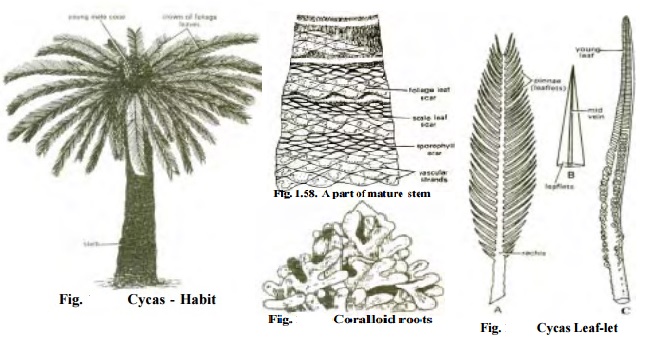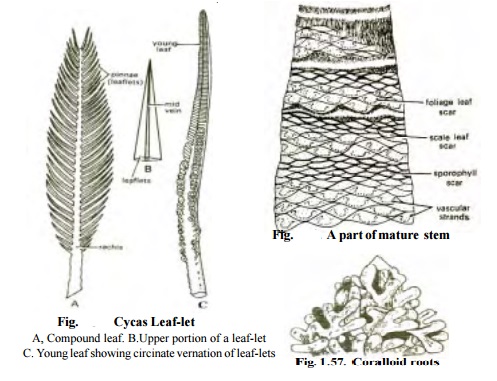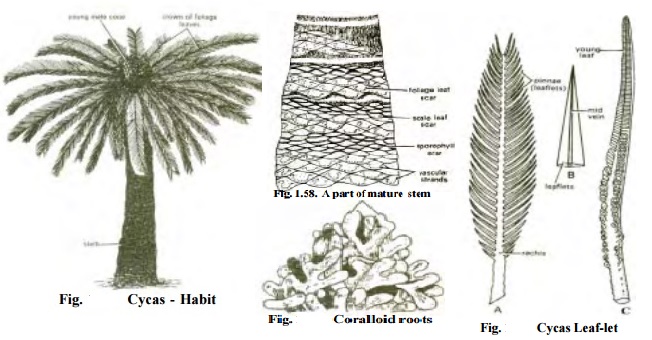Chapter: 11th 12th standard bio zoology Human Body higher secondary school
Cycas - Morphology of sporophyte

Cycas
Division : Cycadophyta
Class : Cycadopsida
Order : Cycadales
Family : Cycadaceae
Genus : Cycas
Gymnosperms are plants which produce naked seeds
i.e., plants which lack ovary and hence do not produce fruits. Cycas belongs to
this group of plants.
The genus cycas
is the most widely distributed genus of the order cycadales. There are about 20
species which grow in the wilderness in China, Japan, Australia, Africa, Nepal,
Bangladesh, Burma and India. C.
circinalis, C. pectinata, C. rumphii and C. beddomei, are found in the wilderness in India. C. revoluta is grown in gardens in
India.
Species of
Cycas are of considerable economic importance. Starch is extracted from several
species of cycas. Young succulent leaves are used as vegetable in some parts of
India. Several species of cycas are of
medicinal value. The juice of young leaves of C. circinalis is used as a remedy
for stomach disorders, flatulence, blood vomiting and skin diseases. The
decoction of young seeds of this species is purgative and emetic. A tincture
prepared from the seeds of C. revoluta is used to relieve headache, giddiness
and sore throat.
Morphology of sporophyte: Cycas is an evergreen slow-growing palm-like small tree with an average
height of 1.5 to 3 meters (fig). It is commonly found in dry habitats. It also
grows well in gardens of tropical countries Fig. 1.56. Cycas - Habit including
India. The sporophyte is differentiated into roots, stem, and leaves.

Roots: There are
two types of roots in cycas 1) Normal roots, 2) Negatively geotropic roots
called coralloid roots.
Normal
roots:
The long-lived primary root is usually thick and short but the lateral roots
are thin and long. These roots are positively geotropic. Their main functions
are anchorage and absorption of water and mineral nutrients.
Coralloid
roots: These
roots are n e g a t i v e l y geotropic and grow on the surface of the soil.
They are dichotomously branched and appear as coralline masses (fig). A
specific algal zone with colonies of Anabaena or other blue green algae is
present in the cortex of these roots. The algal cells may help in N2 fixation.
These roots respire through special openings called lenticels.
Stem:
The
young stem is tuberous and subterranean and its apical part is covered with
brown scale leaves. The old stem is thick, columnar and woody. It is covered
with persistent and woody leaf bases. The stem is usually unbranched, but
sometimes due to shoot tip injury, the stem branches dichotomously.
Leaves: Cycas has
dimorphic leaves namely 1) Foliage or assimilatory leaves and 2) Scale leaves.
1.Foliage
or assimilatory leaves
Large, pinnately compound (fig) foliage
leaves form a crown at the top of the stem. Each leaf has 80-100 pairs of
leaflets. They are arranged on both sides of the rachis in opposite or
alternate manner. The leaflets are sessile, elongated and ovate or lanceolate
with flat or revolute margins. The tip of each leaflet is acute or spiny. Each
leaflet has a single midvein. Lateral veins are absent.
The rachis of a very young leaf is
circinate with circinately coiled leaflets like those of ferns.
2.Scale
leaves

These are small, rough, dry and
triangular in shape. They protect the shoot apex and other aerial parts. They
do not produce starch by photosynthesis. The foliage and scale leaves are
arranged in close alternate whorls at the apex of the stem.

Related Topics